width CHEVROLET TRAVERSE 2009 1.G Owners Manual
[x] Cancel search | Manufacturer: CHEVROLET, Model Year: 2009, Model line: TRAVERSE, Model: CHEVROLET TRAVERSE 2009 1.GPages: 422, PDF Size: 2.06 MB
Page 25 of 422
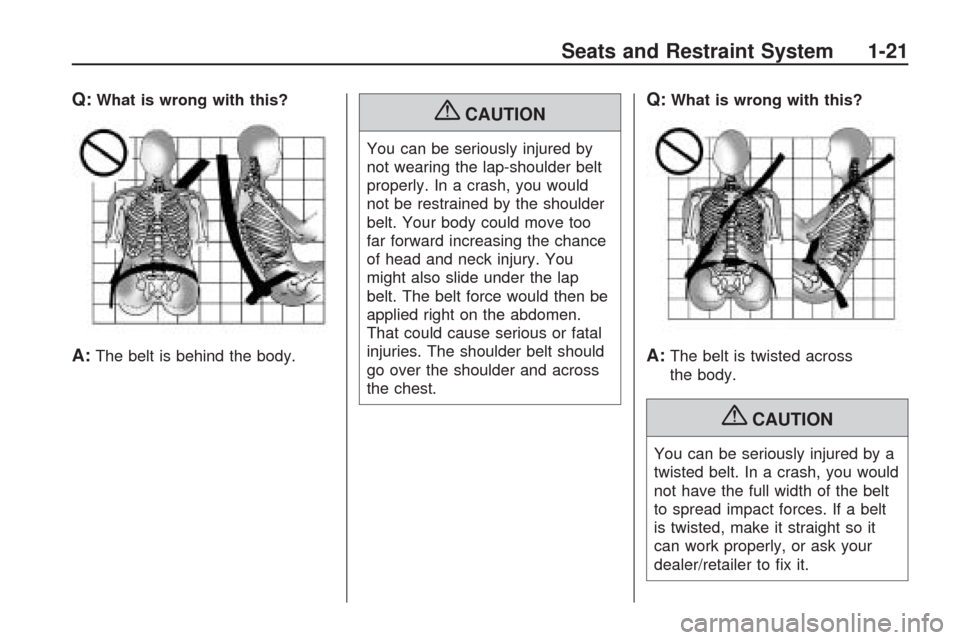
Q:What is wrong with this?
A:The belt is behind the body.
{CAUTION
You can be seriously injured by
not wearing the lap-shoulder belt
properly. In a crash, you would
not be restrained by the shoulder
belt. Your body could move too
far forward increasing the chance
of head and neck injury. You
might also slide under the lap
belt. The belt force would then be
applied right on the abdomen.
That could cause serious or fatal
injuries. The shoulder belt should
go over the shoulder and across
the chest.
Q:What is wrong with this?
A:The belt is twisted across
the body.
{CAUTION
You can be seriously injured by a
twisted belt. In a crash, you would
not have the full width of the belt
to spread impact forces. If a belt
is twisted, make it straight so it
can work properly, or ask your
dealer/retailer to �x it.
Seats and Restraint System 1-21
Page 319 of 422
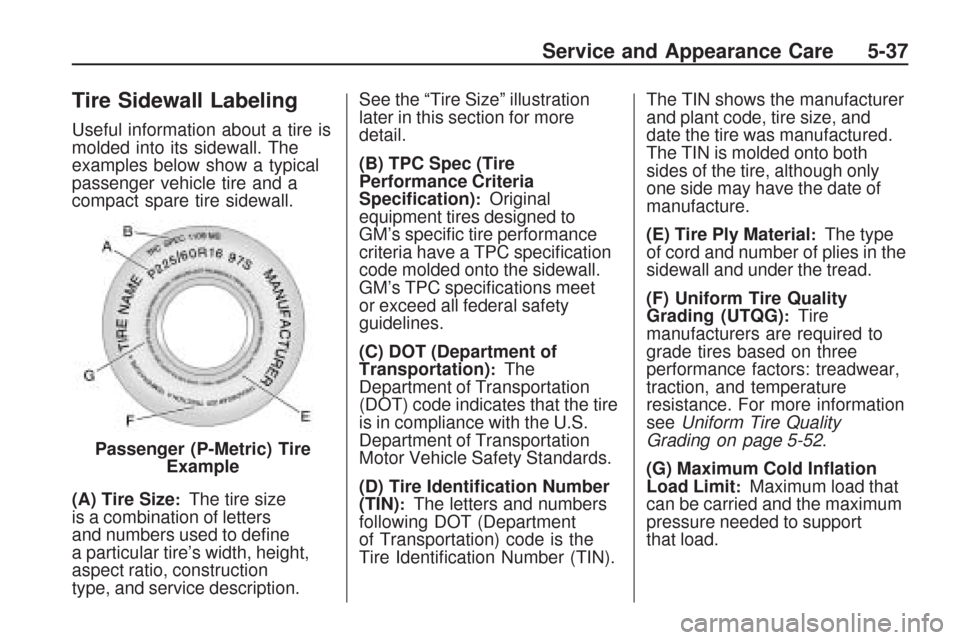
Tire Sidewall Labeling
Useful information about a tire is
molded into its sidewall. The
examples below show a typical
passenger vehicle tire and a
compact spare tire sidewall.
(A) Tire Size
:The tire size
is a combination of letters
and numbers used to de�ne
a particular tire’s width, height,
aspect ratio, construction
type, and service description.See the “Tire Size” illustration
later in this section for more
detail.
(B) TPC Spec (Tire
Performance Criteria
Speci�cation)
:Original
equipment tires designed to
GM’s speci�c tire performance
criteria have a TPC speci�cation
code molded onto the sidewall.
GM’s TPC speci�cations meet
or exceed all federal safety
guidelines.
(C) DOT (Department of
Transportation)
:The
Department of Transportation
(DOT) code indicates that the tire
is in compliance with the U.S.
Department of Transportation
Motor Vehicle Safety Standards.
(D) Tire Identi�cation Number
(TIN)
:The letters and numbers
following DOT (Department
of Transportation) code is the
Tire Identi�cation Number (TIN).The TIN shows the manufacturer
and plant code, tire size, and
date the tire was manufactured.
The TIN is molded onto both
sides of the tire, although only
one side may have the date of
manufacture.
(E) Tire Ply Material
:The type
of cord and number of plies in the
sidewall and under the tread.
(F) Uniform Tire Quality
Grading (UTQG)
:Tire
manufacturers are required to
grade tires based on three
performance factors: treadwear,
traction, and temperature
resistance. For more information
seeUniform Tire Quality
Grading on page 5-52.
(G) Maximum Cold In�ation
Load Limit
:Maximum load that
can be carried and the maximum
pressure needed to support
that load. Passenger (P-Metric) Tire
Example
Service and Appearance Care 5-37
Page 320 of 422
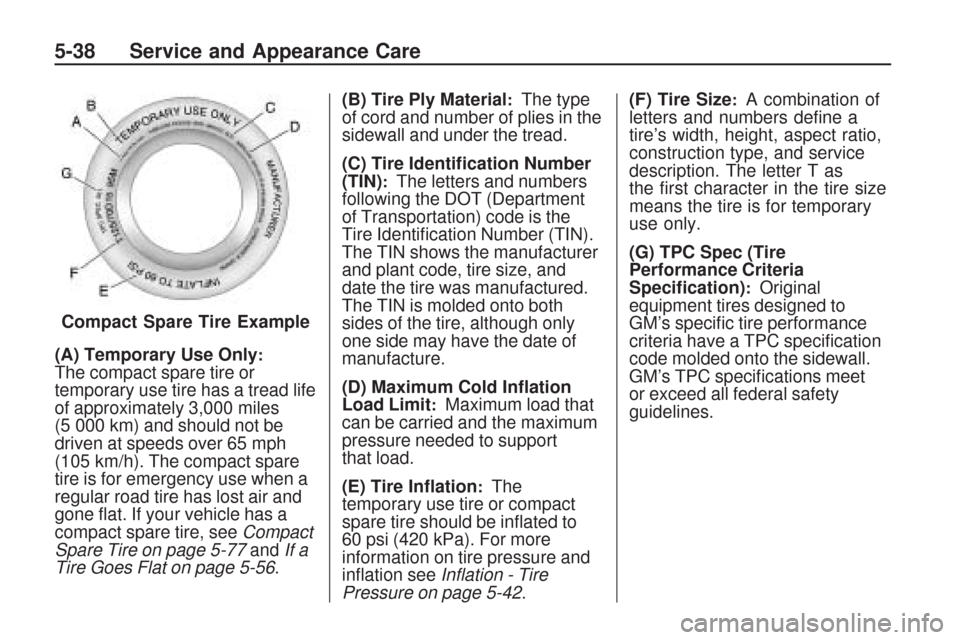
(A) Temporary Use Only:The compact spare tire or
temporary use tire has a tread life
of approximately 3,000 miles
(5 000 km) and should not be
driven at speeds over 65 mph
(105 km/h). The compact spare
tire is for emergency use when a
regular road tire has lost air and
gone �at. If your vehicle has a
compact spare tire, seeCompact
Spare Tire on page 5-77andIf a
Tire Goes Flat on page 5-56.(B) Tire Ply Material
:The type
of cord and number of plies in the
sidewall and under the tread.
(C) Tire Identi�cation Number
(TIN)
:The letters and numbers
following the DOT (Department
of Transportation) code is the
Tire Identi�cation Number (TIN).
The TIN shows the manufacturer
and plant code, tire size, and
date the tire was manufactured.
The TIN is molded onto both
sides of the tire, although only
one side may have the date of
manufacture.
(D) Maximum Cold In�ation
Load Limit
:Maximum load that
can be carried and the maximum
pressure needed to support
that load.
(E) Tire In�ation
:The
temporary use tire or compact
spare tire should be in�ated to
60 psi (420 kPa). For more
information on tire pressure and
in�ation seeInflation - Tire
Pressure on page 5-42.(F) Tire Size
:A combination of
letters and numbers de�ne a
tire’s width, height, aspect ratio,
construction type, and service
description. The letter T as
the �rst character in the tire size
means the tire is for temporary
use only.
(G) TPC Spec (Tire
Performance Criteria
Speci�cation)
:Original
equipment tires designed to
GM’s speci�c tire performance
criteria have a TPC speci�cation
code molded onto the sidewall.
GM’s TPC speci�cations meet
or exceed all federal safety
guidelines. Compact Spare Tire Example
5-38 Service and Appearance Care
Page 321 of 422
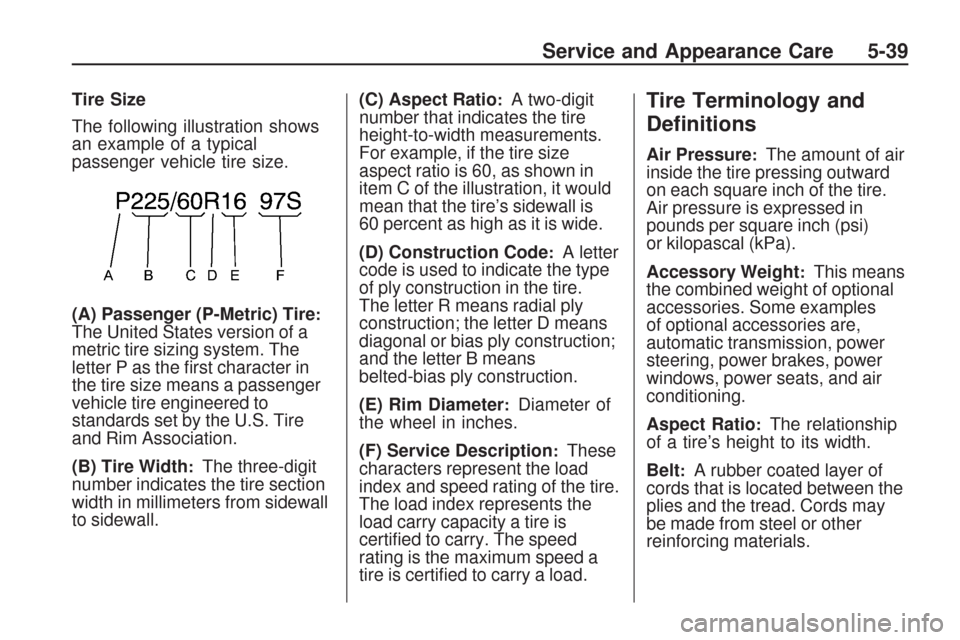
Tire Size
The following illustration shows
an example of a typical
passenger vehicle tire size.
(A) Passenger (P-Metric) Tire
:The United States version of a
metric tire sizing system. The
letter P as the �rst character in
the tire size means a passenger
vehicle tire engineered to
standards set by the U.S. Tire
and Rim Association.
(B) Tire Width
:The three-digit
number indicates the tire section
width in millimeters from sidewall
to sidewall.(C) Aspect Ratio
:A two-digit
number that indicates the tire
height-to-width measurements.
For example, if the tire size
aspect ratio is 60, as shown in
item C of the illustration, it would
mean that the tire’s sidewall is
60 percent as high as it is wide.
(D) Construction Code
:A letter
code is used to indicate the type
of ply construction in the tire.
The letter R means radial ply
construction; the letter D means
diagonal or bias ply construction;
and the letter B means
belted-bias ply construction.
(E) Rim Diameter
:Diameter of
the wheel in inches.
(F) Service Description
:These
characters represent the load
index and speed rating of the tire.
The load index represents the
load carry capacity a tire is
certi�ed to carry. The speed
rating is the maximum speed a
tire is certi�ed to carry a load.
Tire Terminology and
De�nitions
Air Pressure:The amount of air
inside the tire pressing outward
on each square inch of the tire.
Air pressure is expressed in
pounds per square inch (psi)
or kilopascal (kPa).
Accessory Weight
:This means
the combined weight of optional
accessories. Some examples
of optional accessories are,
automatic transmission, power
steering, power brakes, power
windows, power seats, and air
conditioning.
Aspect Ratio
:The relationship
of a tire’s height to its width.
Belt
:A rubber coated layer of
cords that is located between the
plies and the tread. Cords may
be made from steel or other
reinforcing materials.
Service and Appearance Care 5-39
Page 334 of 422
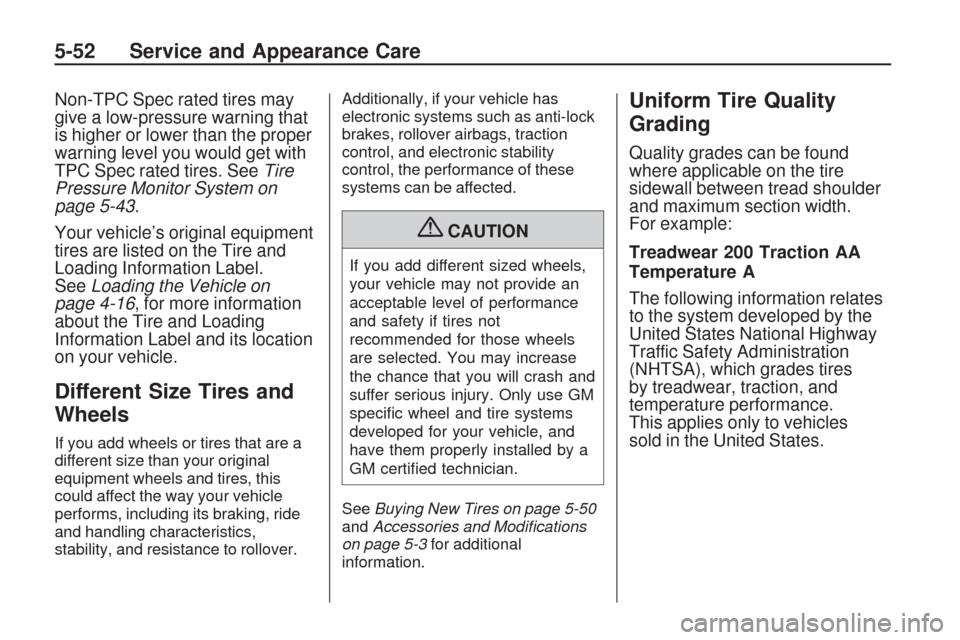
Non-TPC Spec rated tires may
give a low-pressure warning that
is higher or lower than the proper
warning level you would get with
TPC Spec rated tires. SeeTire
Pressure Monitor System on
page 5-43.
Your vehicle’s original equipment
tires are listed on the Tire and
Loading Information Label.
SeeLoading the Vehicle on
page 4-16, for more information
about the Tire and Loading
Information Label and its location
on your vehicle.
Different Size Tires and
Wheels
If you add wheels or tires that are a
different size than your original
equipment wheels and tires, this
could affect the way your vehicle
performs, including its braking, ride
and handling characteristics,
stability, and resistance to rollover.Additionally, if your vehicle has
electronic systems such as anti-lock
brakes, rollover airbags, traction
control, and electronic stability
control, the performance of these
systems can be affected.
{CAUTION
If you add different sized wheels,
your vehicle may not provide an
acceptable level of performance
and safety if tires not
recommended for those wheels
are selected. You may increase
the chance that you will crash and
suffer serious injury. Only use GM
speci�c wheel and tire systems
developed for your vehicle, and
have them properly installed by a
GM certi�ed technician.
SeeBuying New Tires on page 5-50
andAccessories and Modifications
on page 5-3for additional
information.
Uniform Tire Quality
Grading
Quality grades can be found
where applicable on the tire
sidewall between tread shoulder
and maximum section width.
For example:
Treadwear 200 Traction AA
Temperature A
The following information relates
to the system developed by the
United States National Highway
Traffic Safety Administration
(NHTSA), which grades tires
by treadwear, traction, and
temperature performance.
This applies only to vehicles
sold in the United States.
5-52 Service and Appearance Care
Page 336 of 422
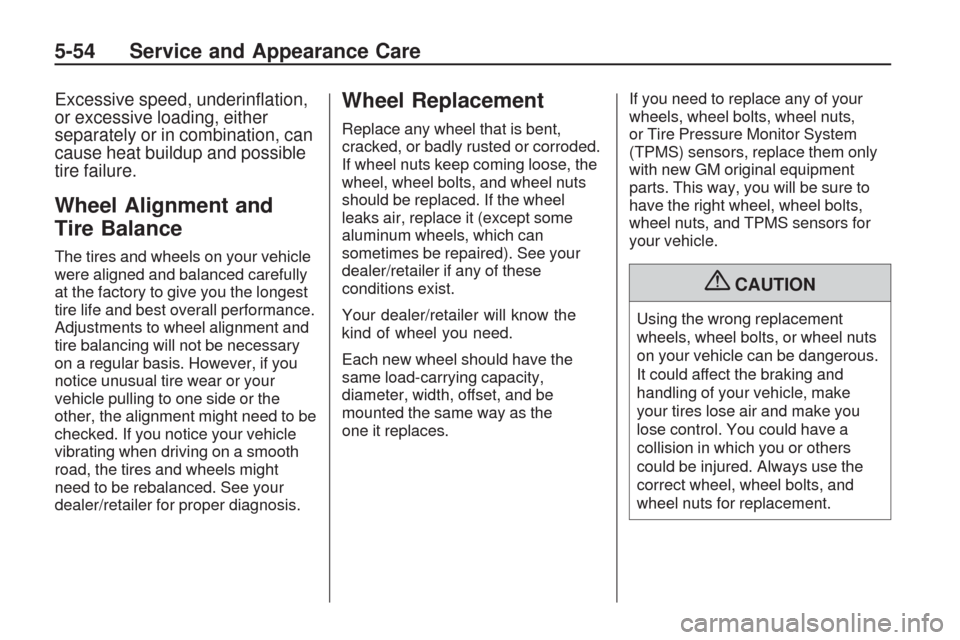
Excessive speed, underin�ation,
or excessive loading, either
separately or in combination, can
cause heat buildup and possible
tire failure.
Wheel Alignment and
Tire Balance
The tires and wheels on your vehicle
were aligned and balanced carefully
at the factory to give you the longest
tire life and best overall performance.
Adjustments to wheel alignment and
tire balancing will not be necessary
on a regular basis. However, if you
notice unusual tire wear or your
vehicle pulling to one side or the
other, the alignment might need to be
checked. If you notice your vehicle
vibrating when driving on a smooth
road, the tires and wheels might
need to be rebalanced. See your
dealer/retailer for proper diagnosis.
Wheel Replacement
Replace any wheel that is bent,
cracked, or badly rusted or corroded.
If wheel nuts keep coming loose, the
wheel, wheel bolts, and wheel nuts
should be replaced. If the wheel
leaks air, replace it (except some
aluminum wheels, which can
sometimes be repaired). See your
dealer/retailer if any of these
conditions exist.
Your dealer/retailer will know the
kind of wheel you need.
Each new wheel should have the
same load-carrying capacity,
diameter, width, offset, and be
mounted the same way as the
one it replaces.If you need to replace any of your
wheels, wheel bolts, wheel nuts,
or Tire Pressure Monitor System
(TPMS) sensors, replace them only
with new GM original equipment
parts. This way, you will be sure to
have the right wheel, wheel bolts,
wheel nuts, and TPMS sensors for
your vehicle.
{CAUTION
Using the wrong replacement
wheels, wheel bolts, or wheel nuts
on your vehicle can be dangerous.
It could affect the braking and
handling of your vehicle, make
your tires lose air and make you
lose control. You could have a
collision in which you or others
could be injured. Always use the
correct wheel, wheel bolts, and
wheel nuts for replacement.
5-54 Service and Appearance Care